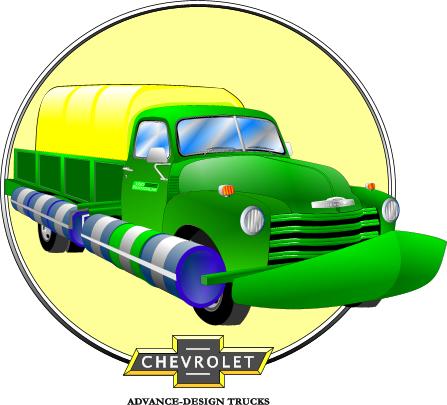 I was minding my own business one day in 2005 when I got a phone call from this English Bloke named Peter Spencer. Peter tells me he is from a movie producing company named PixWorks. I forget how he said he got my name, but he wanted to do a movie based on the real life Saga of Luis Grass and his attempt to float a 1951 Chevy 1-1/2 ton Truck from Cuba to the USA. Logo by my son Kelly at Krehbiel.co.
I was minding my own business one day in 2005 when I got a phone call from this English Bloke named Peter Spencer. Peter tells me he is from a movie producing company named PixWorks. I forget how he said he got my name, but he wanted to do a movie based on the real life Saga of Luis Grass and his attempt to float a 1951 Chevy 1-1/2 ton Truck from Cuba to the USA. Logo by my son Kelly at Krehbiel.co. He went on to say that he was hoping for engineering expertise in duplicating this truck for the movie. I took his word for it because he sounded convincing enough and although we hadn't seen any money yet, I asked a few friends of mine if they would be interested in helping with this project. My team was made up of all engineers who got a kick out of the story and felt compelled to help. Right is the Engineering Team that never was. Left to Right: Deve Krehbiel, Stan Swartzendruber, Richard Swartzendruber, Gene Swartzendruber and Wayne Swartzendruber. In case you are wondering why we are so Swartzendruber heavy in this endeavor it's because those brothers (and son) are renowned in this area for their engineering expertise. You have to honor someone who defied the odds and went to these extremes for his family. So we were pretty excited about it.
He went on to say that he was hoping for engineering expertise in duplicating this truck for the movie. I took his word for it because he sounded convincing enough and although we hadn't seen any money yet, I asked a few friends of mine if they would be interested in helping with this project. My team was made up of all engineers who got a kick out of the story and felt compelled to help. Right is the Engineering Team that never was. Left to Right: Deve Krehbiel, Stan Swartzendruber, Richard Swartzendruber, Gene Swartzendruber and Wayne Swartzendruber. In case you are wondering why we are so Swartzendruber heavy in this endeavor it's because those brothers (and son) are renowned in this area for their engineering expertise. You have to honor someone who defied the odds and went to these extremes for his family. So we were pretty excited about it. 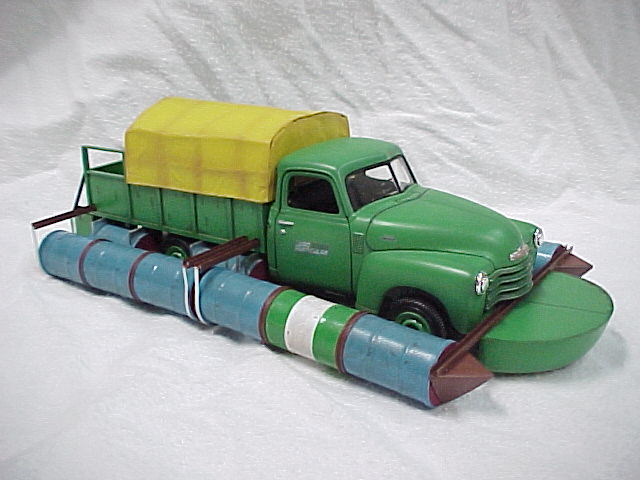 Peter went down to Cuba to interview Luis after his failed attempt. He sent me these pictures of his journey. He said he was able to talk to Luis and he called me from the Dominican Republic to tell me all about his trip. As far as I know these pictures have never been published anywhere before. I never heard from Peter after that, word had it that ABC decided it wasn't worthy of a movie or something, and we were left wondering if we could have pulled it off. I had no doubt whatsoever, but it wasn't to be. The model on the left is something that Peter had commissioned for the movie.
Peter went down to Cuba to interview Luis after his failed attempt. He sent me these pictures of his journey. He said he was able to talk to Luis and he called me from the Dominican Republic to tell me all about his trip. As far as I know these pictures have never been published anywhere before. I never heard from Peter after that, word had it that ABC decided it wasn't worthy of a movie or something, and we were left wondering if we could have pulled it off. I had no doubt whatsoever, but it wasn't to be. The model on the left is something that Peter had commissioned for the movie.Peter's Trip to see Luis and Family
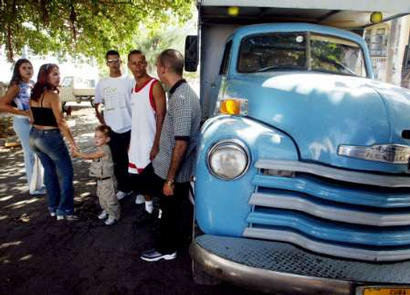


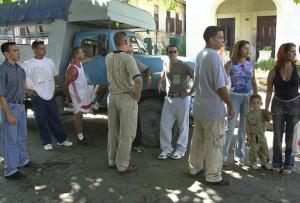

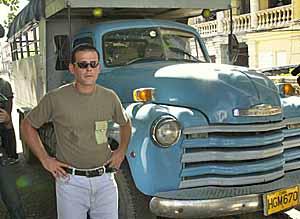
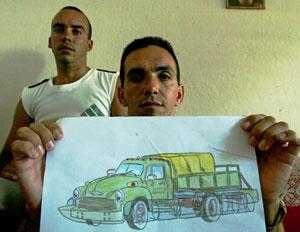



Below Pictures Courtesy of the United States Coast Guard
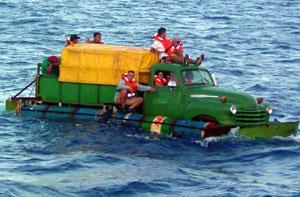

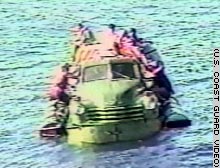

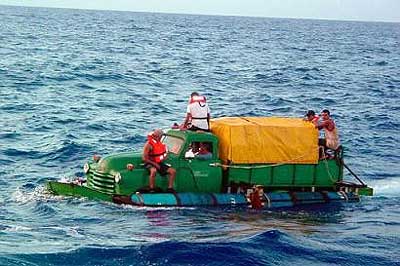
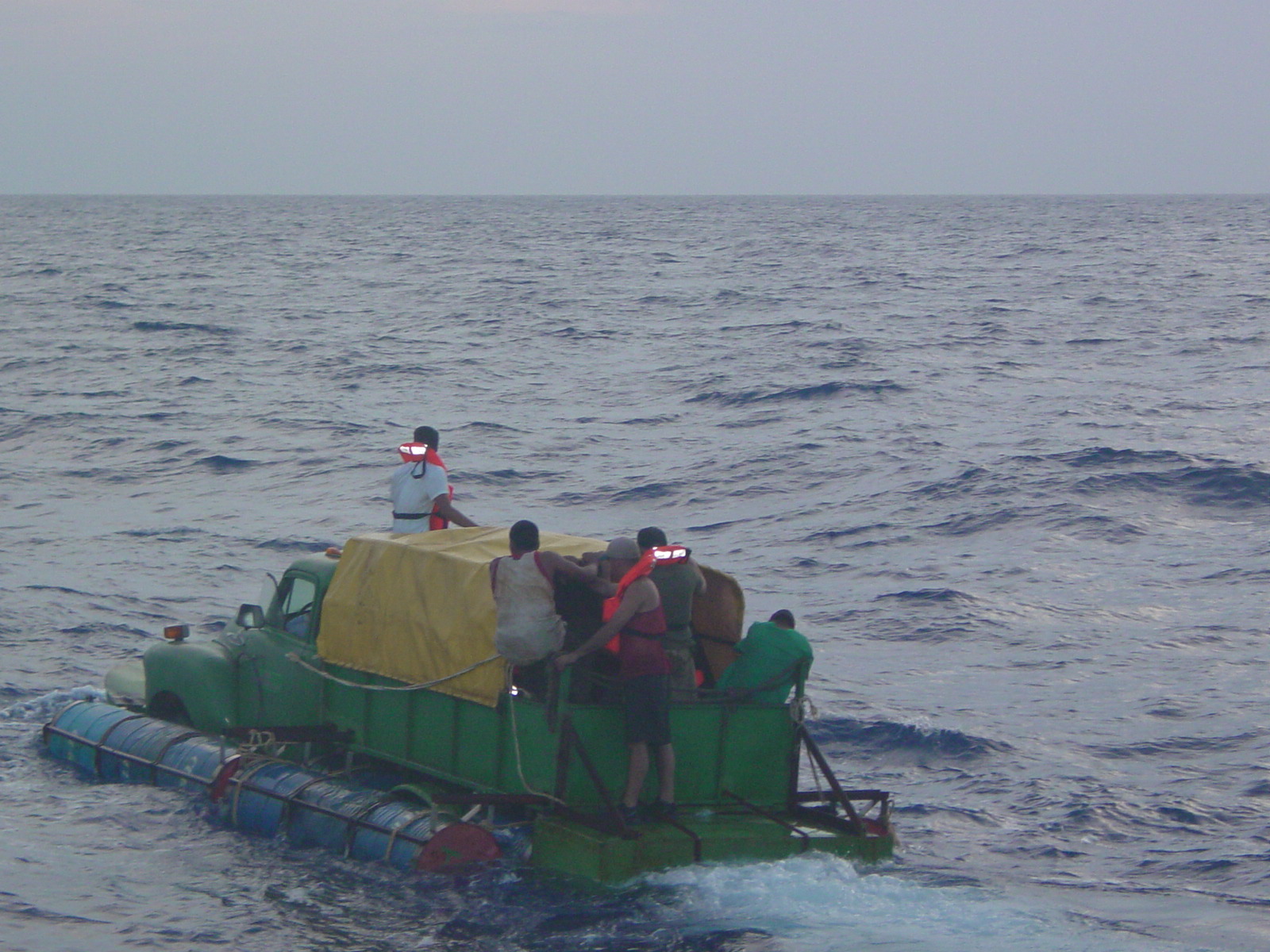
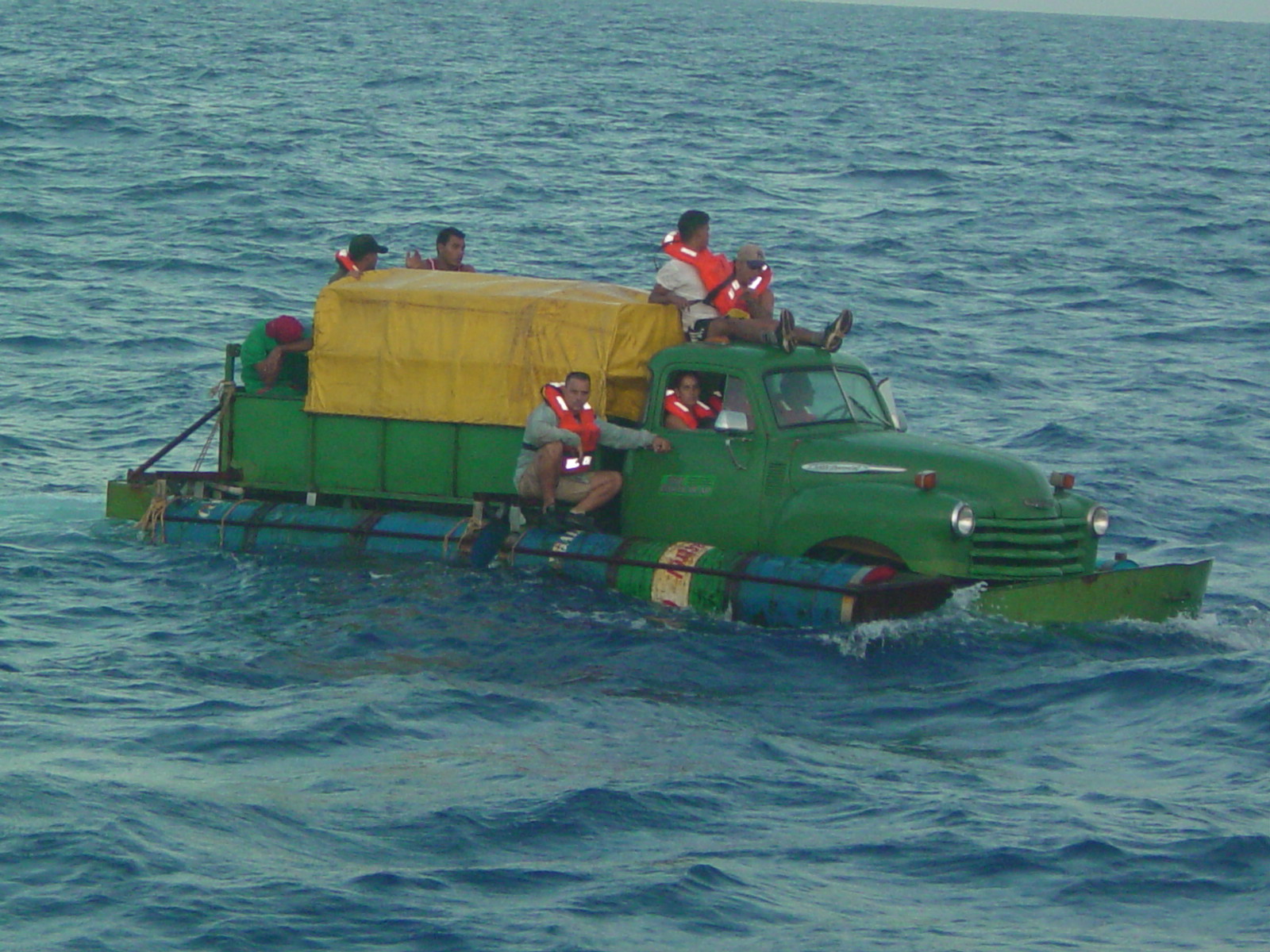
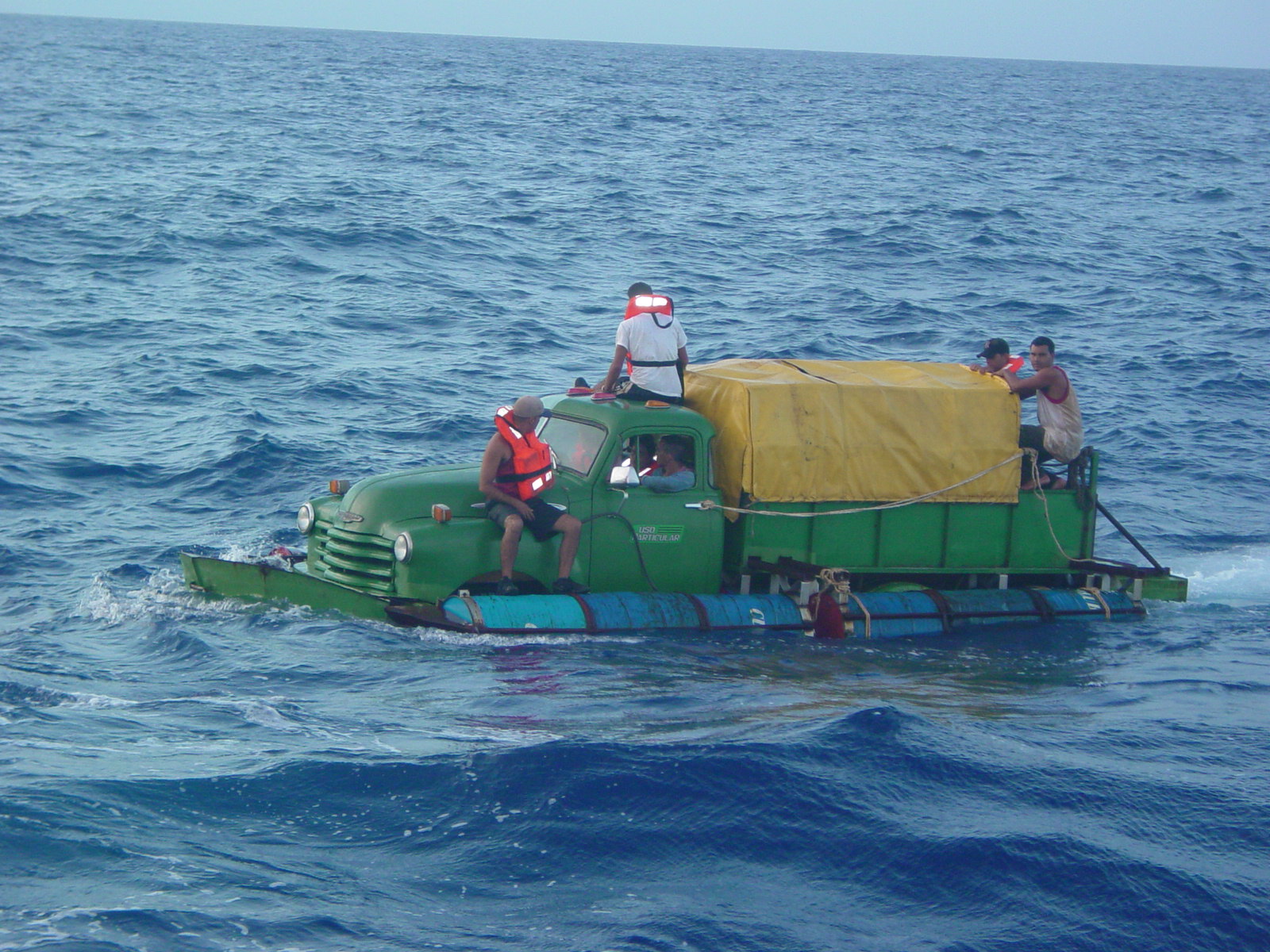
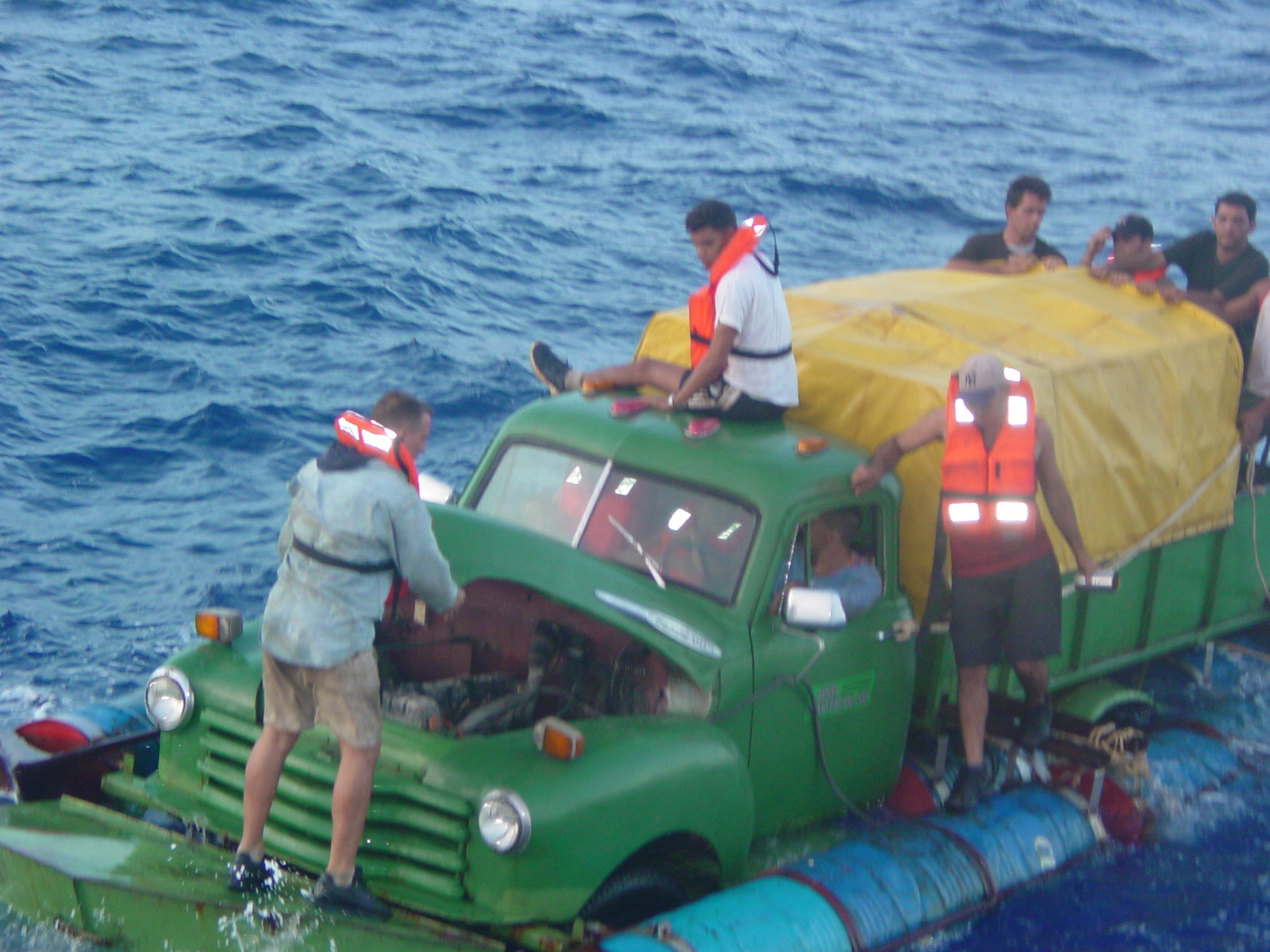


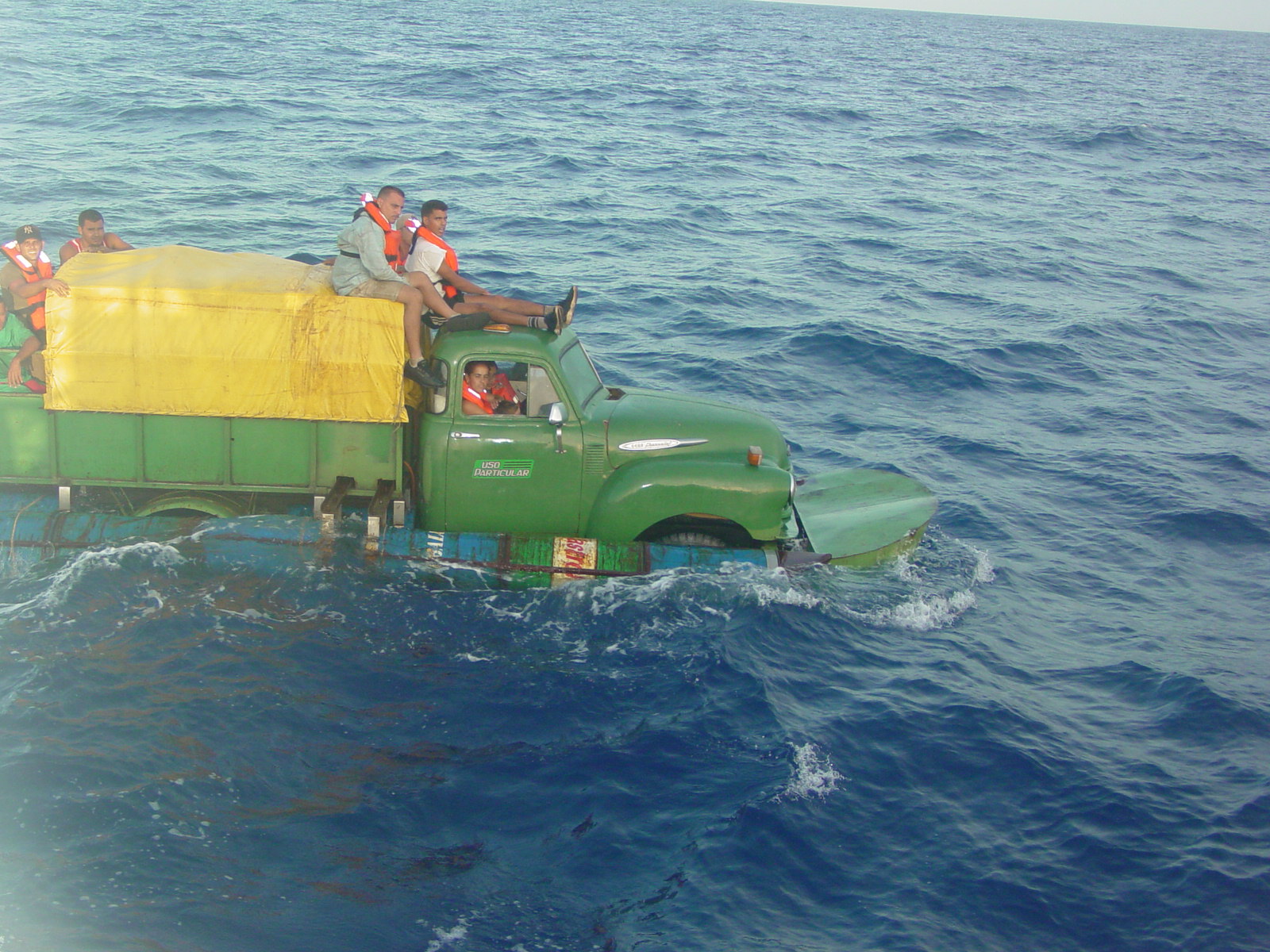
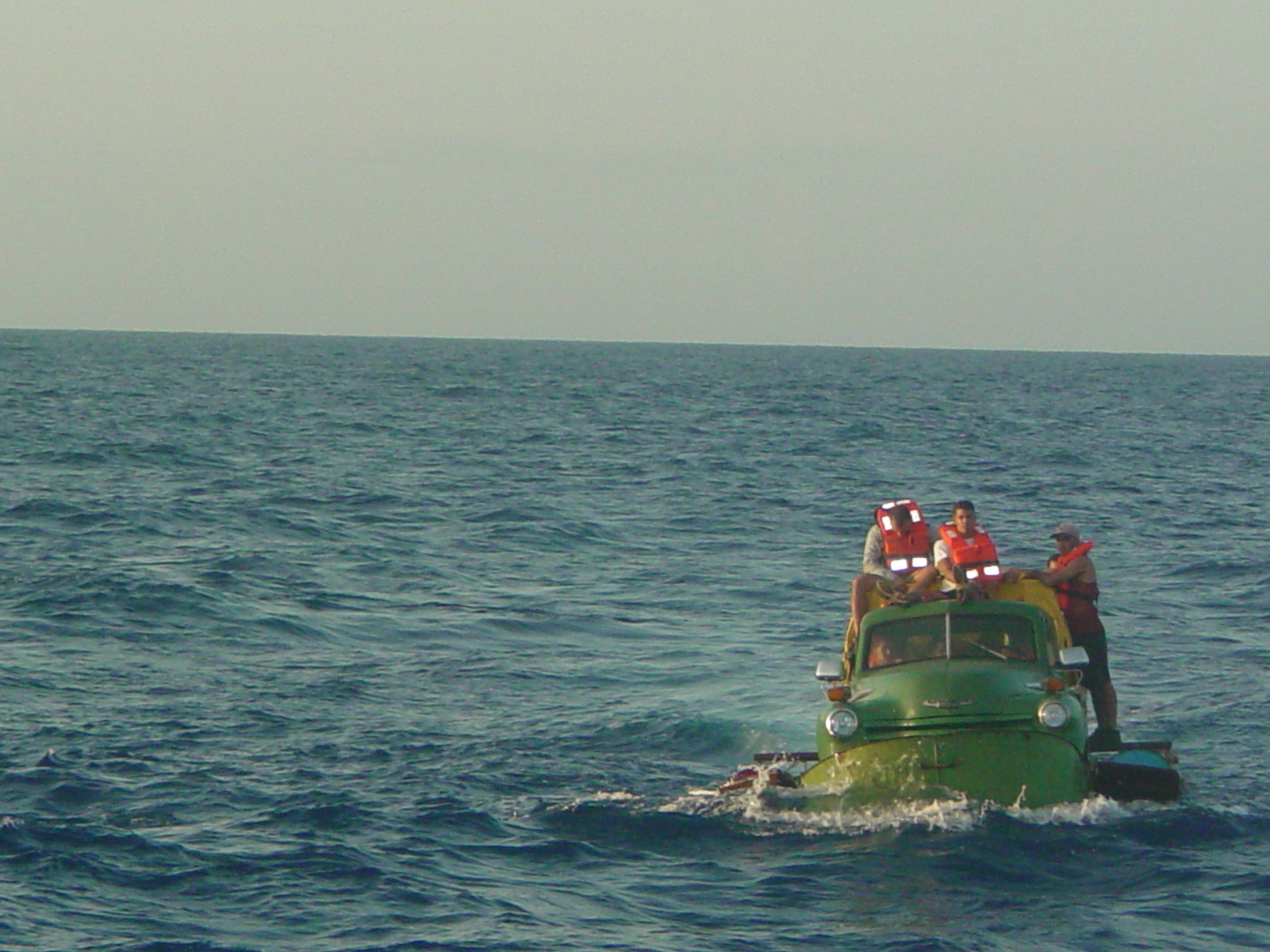
As you may remember, this whole episode got a lot of press. I am attaching a news story from August of 2006 out of Car and Driver Magazine. Long story short, they boarded a Coastguard ship and the Coastguard sunk their precious 1951 Vintage Truck! Maybe we could get Clive Cussler's Expedition to go down and get it?
Car and Driver, August 2006, Sail to the U.S.A. in a Chevrolet
How Luis Grass turned some very old Detroit iron into a seagoing escape vehicle. Twice.
BY JOHN PEARLEY HUFFMAN, PHOTOGRAPHY BY ANTHONY NESTE
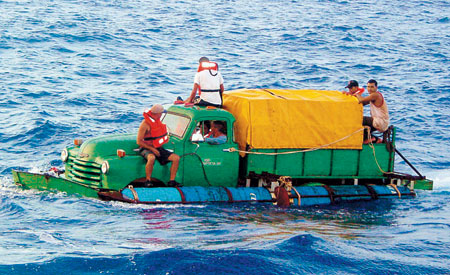 In the '60s, at the height of the Cold War, communist Cuba seemed dangerously close to the United States. After all, 90 miles is no distance at all for a nuclear-tipped ballistic missile. But the Florida Strait is treacherous, a tough 90 miles to cover in any boat. With the Gulf Stream surging through along with the strong Florida Current, it's usually windy with heavy swells. In hurricane season, the murderous storms seem to head right into it. Of course, there are plenty of sharks, too.
In the '60s, at the height of the Cold War, communist Cuba seemed dangerously close to the United States. After all, 90 miles is no distance at all for a nuclear-tipped ballistic missile. But the Florida Strait is treacherous, a tough 90 miles to cover in any boat. With the Gulf Stream surging through along with the strong Florida Current, it's usually windy with heavy swells. In hurricane season, the murderous storms seem to head right into it. Of course, there are plenty of sharks, too.But it's vastly more perilous crossing it in a Chevrolet, Buick, or Mercury. "In the ocean the biggest boat is still, like, a little thing," explains Luis Grass, now 38, who in July 2003 took 11 of his family and friends and almost made it to the U.S. aboard a green 1951 Chevrolet two-ton truck he had made, if not strictly seaworthy, at least seaworthy enough.
Whatever the motivation; economic, political, religious, or familial, Cubans have a massive incentive to risk their lives trying to make it to the U.S. "The way it works is that any Cuban who reaches the United States is automatically entitled to stay," says David Abraham, a professor of immigration and citizenship law at the University of Miami, explaining the situation created by the Cuban Adjustment Act of 1966, "and after one year, to pursue citizenship. This is not offered to any other country's citizens. It doesn't matter if that's Haiti, Canada, or Jamaica. Cuba is the only exception. The issue then is: What does it mean to reach?"
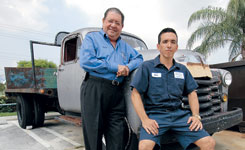 Currently, reach means, in practical terms, setting foot on dry land. "It's the wet-foot/dry-foot agreement," Abraham explains, describing the compromise policy that emerged after the 1994 balsero ("rafter") crisis, when Fidel Castro responded to riots in Havana by announcing that his government would no longer prevent "illegal" departures and thousands of Cubans fled the island on makeshift rafts. "If they reach the shore," Abraham continues, "they stay. But if they're interdicted at sea, they get a quick interview to determine if, as individuals, they are at risk of being persecuted and, if not, they're sent back to Cuba. What this generates is people who will fight off the Coast Guard to make the shore. Having dry feet means you're home free."
Currently, reach means, in practical terms, setting foot on dry land. "It's the wet-foot/dry-foot agreement," Abraham explains, describing the compromise policy that emerged after the 1994 balsero ("rafter") crisis, when Fidel Castro responded to riots in Havana by announcing that his government would no longer prevent "illegal" departures and thousands of Cubans fled the island on makeshift rafts. "If they reach the shore," Abraham continues, "they stay. But if they're interdicted at sea, they get a quick interview to determine if, as individuals, they are at risk of being persecuted and, if not, they're sent back to Cuba. What this generates is people who will fight off the Coast Guard to make the shore. Having dry feet means you're home free."Luis Grass has the taut, lean body of the tae kwon do competitor he was in Cuba (he says he holds a black belt in the martial art). If he's taller than five foot six, it's not by much, and his perfect posture makes every one of those inches count. Even though his grasp of English is slight (and this writer's Spanish worse), he looks you straight in the eye as you speak, apparently out of courtesy and a sincere attempt to understand all that he can. He's quick, animated, and obviously smart. He's also a confident man, someone fearless enough to load himself, his second wife, Isora, and his young son, Angel Luis, along with nine friends, aboard a 52-year-old truck and drive it into the Atlantic Ocean, trusting that his craftsmanship, navigation skills, and cheap compass would get them to Florida.
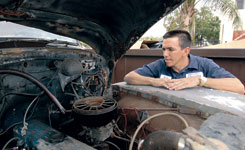 In Havana, Grass made a living hauling sugar cane with his Chevy truck to make guarapo (a beverage based on sugar-cane juice) and running an illegal car-repair shop. When the Cuban government closed his shop and confiscated the truck when he tried to change its title, he decided the time had come to head for Florida. "They took everything away from me, the paperwork and the keys. But I had an extra spare key in the glove compartment." So he used that key to retrieve the truck from the military depot where the government had stored it, a place so chaotic with activity he's not sure they ever knew he took it back. He drove it to his friend Marciel Basanta's house and hid it. "After about 12 days, my wife and some friends went to the beach, and I was looking out at the horizon, and I told my wife, "You know, my love, we have to do this. That's the only way to get out of here. I have no other choice."
In Havana, Grass made a living hauling sugar cane with his Chevy truck to make guarapo (a beverage based on sugar-cane juice) and running an illegal car-repair shop. When the Cuban government closed his shop and confiscated the truck when he tried to change its title, he decided the time had come to head for Florida. "They took everything away from me, the paperwork and the keys. But I had an extra spare key in the glove compartment." So he used that key to retrieve the truck from the military depot where the government had stored it, a place so chaotic with activity he's not sure they ever knew he took it back. He drove it to his friend Marciel Basanta's house and hid it. "After about 12 days, my wife and some friends went to the beach, and I was looking out at the horizon, and I told my wife, "You know, my love, we have to do this. That's the only way to get out of here. I have no other choice."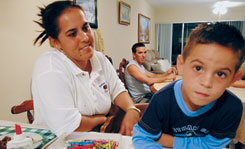 His wife and friends came to the conclusion that he was nuts. But he was determined, so he went home, drew up some plans, and then started scheming ways to scrounge together the necessary parts and pieces to turn his truck into an ocean liner of sorts.
His wife and friends came to the conclusion that he was nuts. But he was determined, so he went home, drew up some plans, and then started scheming ways to scrounge together the necessary parts and pieces to turn his truck into an ocean liner of sorts.Grass had more than just intuition to apply when modifying his truck. He had trained as a naval engineer in Cuba but dropped out of the program during the fourth of his six years of study when, he says, the military commitment and the Communist Party membership that go with such training kicked in. So, on an island nation where private ownership of boats is illegal, he was one of the few people who knew how to build them.
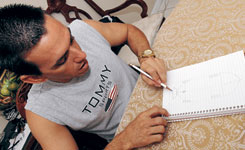 Turning an ancient Chevy truck into an oceangoing vessel is actually rather straightforward. Working in a makeshift shop at Basanta's house, the two men sealed the bottom of the truck into a relatively flat hull with welded sheetmetal.
Turning an ancient Chevy truck into an oceangoing vessel is actually rather straightforward. Working in a makeshift shop at Basanta's house, the two men sealed the bottom of the truck into a relatively flat hull with welded sheetmetal.To stabilize it, six empty oil drums made of steel were lashed to each side to form pontoons, and a small prow was fabricated to sit ahead of the front bumper and cut through the water. Another section of hull was lashed behind the truck to balance the vehicle relative to its height and width. Power came from the truck's ancient 235-cubic-inch six-cylinder engine (rated at 92 horsepower when it was new, before a half-century's seasoning in Cuban agriculture) with a transfer case behind the transmission feeding a second driveshaft and ultimately a 16-inch propeller Grass had scavenged. Cables attached to the tie-rod ends ran back to a fabricated rudder so that turning the truck's steering wheel moved it appropriately (there was also a tiller, should the cables fail).
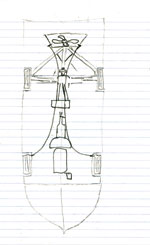 To launch the truck, all Grass and his crew had to do was drive across the hard-packed sands of Havana's Brisas Del Mar beach (a popular departure point for rafters) into the Atlantic and then head north. Once they hit another beach in the U.S., Grass figured, they would "drive directly to a gas station, buy some gas, and drive it" to Miami. That's the clear advantage sailing a truck to Florida has over a raft.
To launch the truck, all Grass and his crew had to do was drive across the hard-packed sands of Havana's Brisas Del Mar beach (a popular departure point for rafters) into the Atlantic and then head north. Once they hit another beach in the U.S., Grass figured, they would "drive directly to a gas station, buy some gas, and drive it" to Miami. That's the clear advantage sailing a truck to Florida has over a raft.Laden with about 106 gallons of surreptitiously accumulated gasoline and enough provisions to sustain the 12 people aboard, the Chevrolet entered the surf at 3 a.m. in the darkness, at high tide, on July 15, 2003, and started its slog across the strait. It turns out that 1951 Chevy two-ton trucks aren't hydrodynamically efficient. Although the truck was stable and might have been capable of three or four knots under ideal circumstances, during this 31-hour voyage, the Chevy only made it to within about 40 miles of the Florida coast.
Grass spent most of that time in the truck's cab as pilot and captain, while the passengers held fast in the truck's bed, protected by a canvas cover and eating cold cuts and crackers. Sometimes one or two would wander onto the pontoons, but even though the seas were unusually calm, most of them got seasick. Although it was hardly a luxurious voyage, the Chevy was slow and stable and chugged on reliably. It never came close to sinking. But it was spotted by a U.S. Customs aircraft and intercepted by the Coast Guard.
"They lied," Grass claims of his first encounter with the Coast Guard. "They told me they had an immigration official on board [the cutter] and that we might be able to get into the United States. But I didn't want to give them the truck because it was my property. And they said, "We're not going to sink it. We're going to put it in a museum."
"He may have misunderstood because he doesn't speak English," says Luis Diaz, a public-affairs official for the Coast Guard. "We would not take out a cutter just to be a tow service." The Coast Guard's district commander at the time, Rear Admiral Harvey Johnson, also told the Miami Herald that the truck had been sunk because its survival and probable public display (in a museum exhibit or otherwise) would have been "an encouragement for people in Cuba to think they need to make it to the United States." The Coast Guard ends up caught between enforcing immigration laws and a law that grants a direct path to citizenship to Cubans who make it to dry land.
So after everyone was off the truck and safely aboard the cutter, the Coast Guard used the automatic fire of their deck guns to sink the ancient green truck. "It was sinking," Grass recalls painfully, who was given earplugs before the shooting began, "and you could still see, like, the top of it. Then they came back and kept shooting at it, and it kept coming back." But eventually, it went down and stayed down.
By the time the Coast Guard took the truck's occupants to the U.S. Naval Base at Guantanamo Bay, Cuba, for three days of processing back into their native country, their story had gotten a lot of press in Florida, and a new word was forged to describe them: camionautas. In English, that translates to "truckonauts."
Although Cuba promises to allow intercepted citizens returned there by the U.S. to go to their homes, on his return Grass spent seven days under house arrest at a military base and says he was later harassed. Plus, with his shop closed and no truck, he couldn't really make a living.
So it wasn't long before he was looking for another way to get to Miami. He found it in the form of a derelict '59 Buick four-door Electra hardtop.
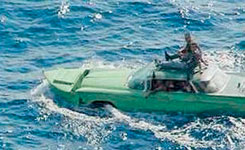 Applying lessons he learned with the truck to the light-green Buick, he built the car-boat using a vee-shaped hull and a more pointed prow to make it faster in the water, and of course it had a Buick V-8 for power. The propeller ran off a transfer case and a second driveshaft and was placed inside a tunnel to maximize its efficiency. As with the truck, the Buick's rear-mounted rudder was controlled by cables connected to the tie-rod ends. There was no need for the pontoons used on the truck.
Applying lessons he learned with the truck to the light-green Buick, he built the car-boat using a vee-shaped hull and a more pointed prow to make it faster in the water, and of course it had a Buick V-8 for power. The propeller ran off a transfer case and a second driveshaft and was placed inside a tunnel to maximize its efficiency. As with the truck, the Buick's rear-mounted rudder was controlled by cables connected to the tie-rod ends. There was no need for the pontoons used on the truck."There was more technology in the Buick," says Grass. "If the car would fill with water, there were pumps that would just throw the water out." Loaded with 11 people (Grass's family plus Basanta's family and another friend, Rafael Diaz, and his family), the Buick set out for Florida at 7 p.m. on February 2, 2004. The oceangoing Buick got within 10 miles of the American coastline before it was again intercepted by the Coast Guard, which claims to have sunk the Buick. But Grass didn't see it go down and doesn't believe it did.
"So the Buick," Grass asserts adamantly, "they wanted to sink it as well. But they couldn't. Because we put Styrofoam into all the compartments. If you would drop it from a third floor into the sea, it would just come back. I think they have it stored. When I was in Guantanamo Bay, an officer told me, "They never sank your boat. It is stored somewhere, and they're going to put it in a museum."
Wherever the Buick wound up, after convincing immigration authorities this time that the consequences in Cuba for them would be grave, the Grass family was interred at Guantanamo Bay while the rest of their fellow truckonauts were sent back into Cuba. And they stayed in Gitmo for a full 10 months while the U.S. government figured out what to do with them. They were treated well there, says Grass, but even a pleasant jail is still a jail, and it was particularly tough on his then-four-year-old son. Eventually, the Grass family forced the issue with a brief hunger strike during September of that year, and they were granted refugee status by Costa Rica. They were flown to that country on December 1, 2004, with the promise of financial aid from the United States to help them adapt to the new surroundings.
But the point of all Luis Grass's efforts was always to get to the U.S., and Miami in particular. So they didn't stay long in Costa Rica.
 By early 2005, Grass and his family were in the process of hitchhiking the 2100-or-so convoluted miles through Nicaragua, Honduras, Guatemala, and Mexico, to finally cross into the U.S. six weeks later in mid-March at Matamoras. That entire journey was done without passports, visas, or any other legal papers, although Grass did pick up financial help from relatives in the U.S. who sent him cash along the way via Western Union. It was a journey Grass says was much more harrowing than his sea voyages.
By early 2005, Grass and his family were in the process of hitchhiking the 2100-or-so convoluted miles through Nicaragua, Honduras, Guatemala, and Mexico, to finally cross into the U.S. six weeks later in mid-March at Matamoras. That entire journey was done without passports, visas, or any other legal papers, although Grass did pick up financial help from relatives in the U.S. who sent him cash along the way via Western Union. It was a journey Grass says was much more harrowing than his sea voyages.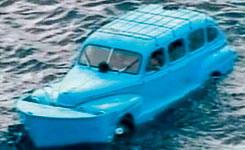 In Texas, the little group applied for political asylum, and after they were held in Brownsville for two days, it was granted. They went straight to Miami.
In Texas, the little group applied for political asylum, and after they were held in Brownsville for two days, it was granted. They went straight to Miami.While Grass was making his overland journey, friend Rafael Diaz was back in Cuba modifying a blue 1948 Mercury airport transport car along the same lines as the Buick. On June 5, 2005, Diaz, his wife and two children, and nine others (including Marciel Basanta and his family) were intercepted just south of the Florida Keys, and because the Diaz family had already arranged U.S. visas, they were allowed into the country. The Coast Guard sank that vehicle, too.
The photographs of the truckonauts at sea make them appear almost cute. Their brightly colored vehicles are undeniably ingenious, and since they were built from ancient and familiar American iron, the affection is immediate. Plus, it's flattering that so much effort would go into an attempt to make it to the Land of the Free. It all plays into our preconceptions of Cuba as a place filled with people yearning for freedom as well as classic American cars from the '50s.
But that all conspires to downplay how seriously dangerous those voyages were. In April this year, the Cuban Coast Guard fired at suspected migrant smugglers and is believed to have killed one person. In April 2005, the U.S. Coast Guard rescued three severely dehydrated Cubans who survived the capsizing of another smuggling craft, their 31 shipmates are not believed to have survived being thrown into the shark-infested waters. The U.S. Coast Guard made 10,716 interdictions at sea (1499 of which were Cubans, third by nationality behind Haitians and Dominicans) during 2004, and no one really knows how many people are drowning trying to get here. The truckonauts were staggeringly lucky.
The Cuban community in and around Miami is a tight one, and the truckonauts were accepted into it. Luis Grass quickly found a job at Maroone Chevrolet of West Dade as a line mechanic and plunged into learning the latest diagnostic tools. His wife took a job making sandwiches at a deli in a Shell station. Diaz found work in a body shop. Basanta and his family, plus Grass's two children from his first marriage, remain in Cuba.
Maroone Chevrolet's general manager, Raúl de la Milera, a Cuban émigré himself, has been working with Grass and other mechanics at the dealership to convert a 1953 Chevrolet truck they located into a near duplicate of the original truckonaut machine. This new truck isn't in great shape, there are places where the body has rotted through, but according to Grass, it's in "much, much better condition" than what he started with in Cuba. It makes his accomplishment that much more impressive.
The Grass family lives in a large, nondescript Hialeah apartment building with Luis's uncle. Their home is spotless, comfortable, and modestly furnished.
One of his first purchases after settling in Florida was a new Chevrolet TrailBlazer. He's a firm fan of GM products, and there was a good rebate available. It would be an unthinkably luxurious vehicle in Cuba, where the per capita gross domestic product is only about $3300, about 1/13th that of the United States, and new vehicles are rare and usually government-owned.
That TrailBlazer has also introduced him to that most American of consumer institutions, GMAC financing. Is it intimidating for him to owe that much money? "No," he says. "In life you have to set goals. Whoever lives in fear doesn't deserve to live."
This article was (in its entirety was first published at DevesTechNet.com (c)2015 All Rights Reserved



 Welcome to Deves Technet.com Forums. I encourage everyone to register so we can get a better idea of the traffic and its usefulness. Please leave a word or two describing your stay and what we can do to make it more enjoyable. Thanks!
Welcome to Deves Technet.com Forums. I encourage everyone to register so we can get a better idea of the traffic and its usefulness. Please leave a word or two describing your stay and what we can do to make it more enjoyable. Thanks!